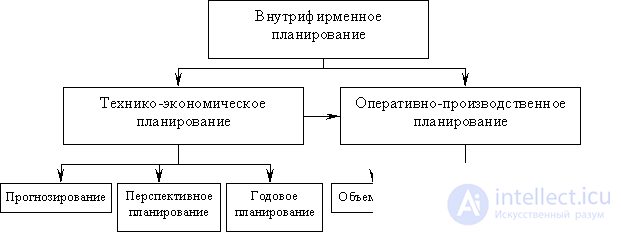Lecture
Planning is one of the most important functions of managing various systems, one of which is industrial production. The task of planning is to set up an action program for the managed subsystem to achieve the goal.
The process of intra-company planning (WWF) is a complex of calculations and procedures of a production and economic nature aimed at establishing and implementing the goals of the production activity of an enterprise during certain planned periods of time (month, quarter, year).
The value of the WFTU is determined by the fact that it:
In addition, the role of planning as the most important function of management is determined by the fact that 70% of management information is associated with different stages of production planning.
WWF is a complex process consisting of a series of successive steps:
I. Statement of tasks . It consists in building a tree of goals that a company needs to solve in order to achieve a given efficiency. Tentatively set deadlines for solving problems, as well as the required amount of resources for their implementation.
Ii. Development plans. It includes the preparation of special plans for achieving each goal separately. When this occurs, the timing of the implementation of each plan is specified and they are linked horizontally (the same time frame for implementation) and vertically. In parallel, there is a distribution of resources available to the company.
Iii. Develop a budget . A comparison of the plans of income and expenses of the enterprise is carried out, which makes it possible to identify and subsequently eliminate a possible imbalance between the required and available resources.
Iv. Concretization of plans (final version). The development of specific measures for the implementation of plans.
When conducting the WWF, there are three levels of development plans for the time:
Perspective plans. This level covers a time perspective of 5 to 15 years. The specific period is determined by the type of activity for which it is developed. Such plans often represent a reflection of the overall strategy of the enterprise. These may include:
Medium-term plans . This level is developed on the basis of the adopted perspective plan and represents its specification and specification. It is created in the future from 2 to 5 years for all types of activities carried out by the company. Each division of the company develops its own medium-term plan. The main areas of medium-term plans are:
Short term plans . Developed for short periods of time (up to one year). The main contents of these plans are:
WFTU is divided into two stages: feasibility planning (TEP) and operational production planning (OPP) * . The components of the WWF are shown in Fig. 9.1.

Fig. 9.1. Intrafirm planning scheme
TEP is engaged in the development of plans for the production, economic and social activities of the company, as well as technical and economic indicators of its operation.
OPP is a logical development of TEP and is carried out in the course of the production program of a certain planned period.
Organizational forms of the WWF. The WFTU * covers all levels of management and is distinguished by a large organizational diversity of forms. In an integrated form, there are two main forms:
In the first case, the administration has a centralized planning service, which develops forward-looking and current plans for the units within the firm.
In the second form of organization, the enterprises included in the association have their own planning and production services that carry out work on current and long-term planning. The top management of the association in this case determines only the general direction of development (for example, the location and structure of capital investments, total production and profits, etc.). The central planning service of the association develops the form of plans and communicates to enterprises the restrictions imposed by general corporate objectives (for example, capital investment limits). The relocation of the center of gravity in the long-term planning to the enterprises is explained by their great independence, wide scale of activity and the specifics of production. Coordination and control over the work of the planning services of individual enterprises is carried out by the central planning service.
Comments
To leave a comment
Management
Terms: Management